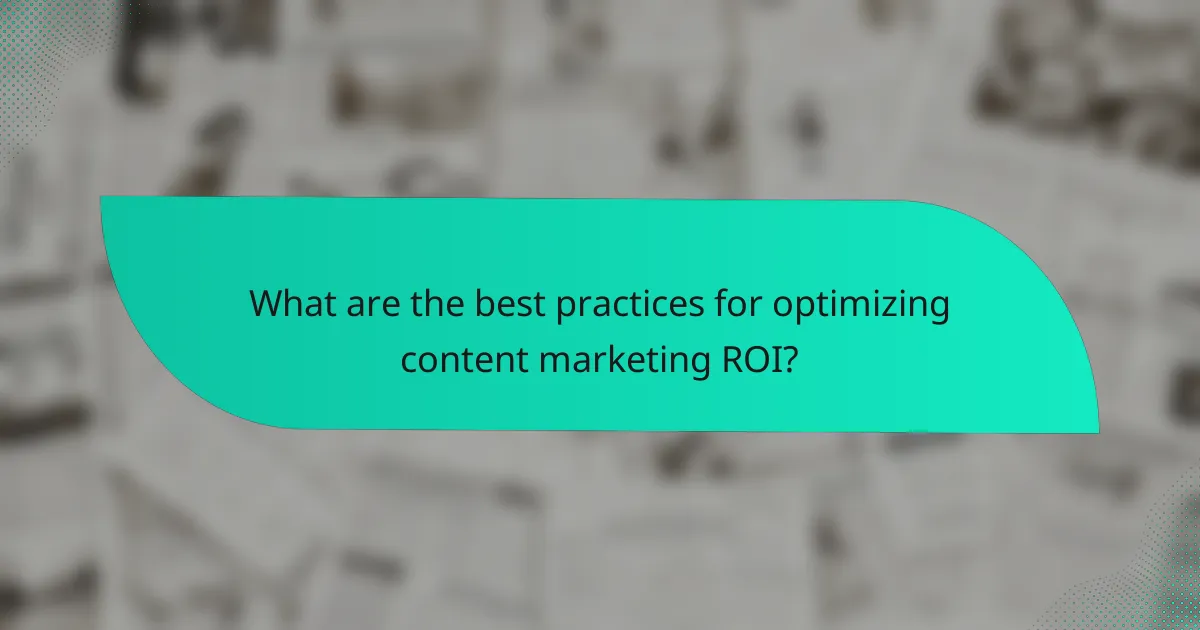Content marketing campaigns require careful consideration of production costs, distribution expenses, and ROI analysis to ensure effectiveness. The costs associated with creating content can fluctuate based on quality and complexity, while distribution expenses depend on the chosen channels and campaign scale. By budgeting effectively and analyzing potential returns, businesses can optimize their resources to achieve their marketing objectives.

What are the content production costs in the UK?
Content production costs in the UK can vary significantly based on the type of content being created. Factors such as quality, complexity, and the expertise of the creators play a crucial role in determining these expenses.
Average costs for video production
Video production costs in the UK typically range from a few hundred to several thousand pounds, depending on the project’s scale and requirements. Basic promotional videos may start around £1,000, while high-quality corporate videos can exceed £10,000.
When budgeting for video production, consider elements like scripting, filming, editing, and post-production. Hiring a professional crew and using advanced equipment will increase costs but can significantly enhance the final product’s quality.
Costs for blog writing services
Blog writing services in the UK generally charge between £50 and £300 per article, depending on the writer’s expertise and the article’s length. Freelancers may offer lower rates, while established agencies often command higher fees due to their reputation and experience.
When selecting a blog writing service, assess the quality of previous work and the ability to meet deadlines. Investing in well-researched, engaging content can lead to better audience retention and improved SEO performance.
Graphic design expenses
Graphic design costs in the UK can vary widely, with rates typically ranging from £30 to £150 per hour. For specific projects, such as logo design or branding, total costs may range from £200 to over £2,000, depending on the complexity and designer’s experience.
It’s essential to communicate your vision clearly to designers and request portfolios to ensure their style aligns with your brand. Consider the long-term value of quality design, as it can significantly impact brand perception and customer engagement.
Influencer collaboration fees
Influencer collaboration fees in the UK can range from £100 for micro-influencers to tens of thousands of pounds for well-known personalities. Factors influencing these costs include the influencer’s reach, engagement rate, and the nature of the collaboration.
When planning influencer partnerships, focus on aligning with influencers whose audience matches your target demographic. This alignment can enhance the effectiveness of your campaign and provide a better return on investment.

How to budget for content marketing campaigns?
Budgeting for content marketing campaigns involves estimating costs for production and distribution while analyzing potential returns. A well-structured budget ensures that resources are allocated effectively to maximize impact and achieve business goals.
Creating a detailed budget plan
Start by listing all potential costs associated with your content marketing campaign. This includes expenses for content creation, such as hiring writers, graphic designers, and video producers, as well as tools for editing and publishing.
Consider breaking down your budget into categories like pre-production, production, and post-production. A typical content marketing budget might range from a few hundred to several thousand dollars, depending on the scope and scale of your campaign.
Allocating funds for distribution
Distribution is crucial for ensuring your content reaches the intended audience. Allocate a portion of your budget specifically for promoting your content through channels like social media ads, email marketing, and paid search.
As a guideline, consider spending around 20-30% of your total content budget on distribution. This investment can significantly enhance visibility and engagement, leading to better results.
Estimating ROI
Estimating return on investment (ROI) for content marketing involves measuring the revenue generated against the costs incurred. Track key performance indicators (KPIs) such as website traffic, lead generation, and conversion rates to assess effectiveness.
A simple formula to calculate ROI is: (Net Profit / Cost of Investment) x 100. Aim for a positive ROI, ideally above 100%, which indicates that your campaign is generating more revenue than it costs.

What are the distribution expenses for content marketing?
Distribution expenses for content marketing encompass the costs associated with promoting and delivering content to the target audience. These expenses can vary significantly based on the channels used and the scale of the campaign.
Costs of social media advertising
Social media advertising costs can range from a few cents to several dollars per click, depending on the platform and targeting options. For instance, Facebook and Instagram typically charge between $0.50 and $3.00 per click, while LinkedIn may cost $5.00 or more due to its professional audience.
When budgeting for social media ads, consider factors like audience size, ad format, and campaign duration. It’s essential to monitor performance metrics to optimize spending and maximize reach.
Email marketing expenses
Email marketing expenses generally include costs for email service providers (ESPs), which can range from free plans for small lists to hundreds of dollars monthly for larger campaigns. Many ESPs charge based on the number of subscribers or emails sent.
In addition to ESP fees, consider costs for creating engaging content, such as design and copywriting. A/B testing can also incur additional expenses but is crucial for improving open and click-through rates.
Paid search advertising costs
Paid search advertising costs, often associated with platforms like Google Ads, typically operate on a pay-per-click (PPC) model. Costs can vary widely, with average CPC rates ranging from $1.00 to $2.00 for most industries, but competitive sectors may see costs exceeding $10.00 per click.
To manage paid search expenses effectively, set a clear budget and use keyword research tools to identify cost-effective keywords. Regularly review and adjust bids based on performance to ensure optimal ROI.

How to analyze ROI for content marketing campaigns?
To analyze ROI for content marketing campaigns, evaluate the revenue generated against the costs incurred. This involves calculating both production and distribution expenses and comparing them to the financial returns from the campaign.
Key performance indicators for ROI
Key performance indicators (KPIs) for measuring ROI in content marketing include metrics such as conversion rates, customer acquisition costs, and overall revenue growth. Tracking these KPIs helps determine the effectiveness of content in driving sales and engagement.
For example, a campaign that generates a high number of leads but has a low conversion rate may indicate that while the content is attracting attention, it is not effectively persuading potential customers. Aim for a balanced approach where both lead generation and conversion rates are optimized.
Tools for measuring ROI
There are several tools available for measuring ROI in content marketing, including Google Analytics, HubSpot, and SEMrush. These platforms provide insights into traffic sources, user behavior, and conversion tracking, which are essential for assessing campaign performance.
When selecting a tool, consider factors such as ease of use, integration capabilities, and the specific metrics you wish to track. Many tools offer free trials or tiered pricing, allowing you to choose a solution that fits your budget and needs.

What are the best practices for optimizing content marketing ROI?
To optimize content marketing ROI, focus on measuring performance through analytics, adjusting strategies based on insights, and ensuring that production and distribution costs align with your goals. Implementing these practices will help you maximize returns and minimize waste in your marketing efforts.
Utilizing analytics tools
Analytics tools are essential for tracking the performance of your content marketing campaigns. Platforms like Google Analytics, HubSpot, and SEMrush provide insights into user engagement, traffic sources, and conversion rates. By analyzing this data, you can identify which content resonates with your audience and which does not.
When selecting analytics tools, consider factors such as ease of use, integration capabilities, and the specific metrics you want to track. For instance, if your goal is to increase website traffic, focus on tools that offer detailed reports on page views and visitor behavior.
Adjusting content strategy based on data
Adjusting your content strategy based on data insights is crucial for improving ROI. Regularly review performance metrics and be prepared to pivot your approach if certain types of content are underperforming. For example, if video content generates higher engagement than blog posts, consider increasing your video production efforts.
Establish a feedback loop where data informs your content creation process. Set specific KPIs, such as engagement rates or lead generation, and use these benchmarks to guide your content decisions. Avoid common pitfalls like sticking to a failing strategy simply because it has been in place for a long time; be flexible and responsive to the data.

What are the emerging trends in content marketing?
Emerging trends in content marketing focus on leveraging technology and data to enhance engagement and effectiveness. Key developments include the use of artificial intelligence, personalized content strategies, and a shift towards video and interactive formats.
Impact of AI on content creation
AI significantly influences content creation by automating processes and enhancing creativity. Tools powered by AI can generate written content, analyze audience preferences, and optimize distribution strategies, allowing marketers to produce high-quality material more efficiently.
For example, AI-driven platforms can analyze vast amounts of data to identify trending topics, helping marketers create relevant content that resonates with their target audience. This technology can reduce production costs and time, enabling teams to focus on strategy and creativity.
However, relying solely on AI can lead to generic content. It’s crucial to balance automation with human insight to maintain authenticity and connection with the audience. Marketers should consider using AI as a supplement rather than a replacement for human creativity.
